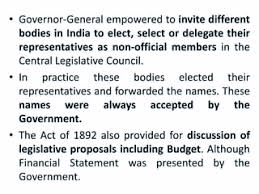The political climate of the subcontinent underwent a big change due to the formation of Indian National Congress in 1885. With growing political awareness the educated class started demanding representative institutions in India. Moreover, the imposition of ‘Vernacular Press Act’, the Afghan policy of the British Government and the ‘Albert Bill’ controversy, all awakened the Indians as a nation to a greater extent. As the attitude of the public was changing Lord Dufferin in 1888, set up a committee with Sir George Chesney to consider the question of Reforms. The Bill was introduced in the House of Lords in 1890 and after a delay of two years, it was passed in 1892.
The number of the ‘Additional Members’ of the Governor General’s Executive Council was raised up to 16 but required not less than ten. Two-fifth of the ‘Additional Members’ was to be non-official. In the Act of 1892 these members were given the power to ask questions in the Councils on matters of public interest only. The number of the Members of the Provincial Councils was also raised, for Bengal it was 20 and 15 for the N.W. Provinces and Oudh. The ‘Additional Members’ were authorized to discuss the annual financial statement under certain conditions and restrictions. Another important provision was that any proposal regarding the expenditure in the annual financial statement would be laid before the Council, only if the Governor General in Council had sanctioned it. The Governor General in Council had the power to frame rules for the nomination of the Members. He was also authorized to fill up vacancies among the additional members.
Though the Indian Councils Act of 1892 was a “cautious extension” of the Act of 1861, yet it was an attempt to form a compromise between the official view of the Council as a ‘pocket legislature’ and the educated Indian view of them as “embryo parliament”. It was during the working of this act that the Indian representatives began to show keen interest in the debates of the Councils and leading members in the Councils were mostly the prominent lawyers in the country. But it too had some shortcomings that included inability of the members to influence the administration on important issues like reduction of military expenditure, taxes and the admission of Indians in the Executive Councils. It was impossible for a non-official member to express any demand against official bloc and sometimes the information was denied if the answer to any question required lengthy preparations by the official member. Moreover the Government passed many bills disregarding the strongest opposition by the Indian members, for example in 1905 the Indian Universities Bill was passed although it was strongly opposed by the Indian members. The Government failed to pay attention to the opinion of non-official members during some vital issues that later took the shape of political grievances.
This article was last updated on Wednesday, Jan 04, 2006






